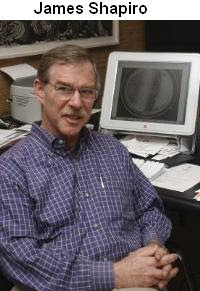I will be attending the Royal Society Meeting on New trends in evolutionary biology: biological, philosophical and social science perspectives. I'll post each of the abstracts and ask for your help in deciding what question to pose to the speakers. Here's the abstract for James Shapiro's talk on Biological action in Read-Write genome evolution.
Many of the most important evolutionary variations that generated phenotypic adaptations and originated novel taxa resulted from complex cellular activities affecting genome content and expression. These activities included: (i) the symbiogenetic cell merger that produced the mitochondrion-bearing ancestor of all extant eukaryotes; (ii) symbiogenetic cell mergers that produced chloroplast-bearing ancestors of photosynthetic eukaryotes; and (iii) interspecific hybridisations and genome doublings that have generated adaptive radiations and new species of higher plants and animals. Adaptive variations have also arisen by horizontal DNA transfers (frequently involving infectious agents), by natural genetic engineering of coding sequence DNA in protein evolution (e.g. exon shuffling), and by mobile DNA rewiring of transcriptional regulatory networks, such as those essential to viviparous reproduction in mammals. In the most highly evolved multicellular organisms, we now know that biological complexity scales with ‘non-coding’ DNA content rather than with protein-coding capacity in the genome. Coincidentally, we have come to recognise that ‘non-coding’ RNAs rich in repetitive mobile DNA sequences function as key regulators of complex adaptive phenotypes, such as stem cell pluripotency. The intersections of cell activities and Read-Write genome modifications provide a rich molecular and biological foundation for understanding how ecological disruptions can stimulate productive, often abrupt, evolutionary transformations.I have dozens of questions for Jim Shapiro but here are two possibilities.
Most of the events you describe are one-off events in the history of life. They are mostly accidents. They were unpredictable. How does the occurrence of unique events such as endosymbiosis or genome doubling fit into evolutionary theory as opposed to just historical facts in the history of life.
OR
Michael Lynch and others say that the amount of junk DNA in a genome correlates with the population size of the species. This view is perfectly consistent with modern population genetics. There is plenty of evidence that 90% of our genome is junk. You seem to be implying that this extra DNA is not junk but serves some adaptive purpose. What evidence do you have that supports this claim and why do you disagree with Michael Lynch?








